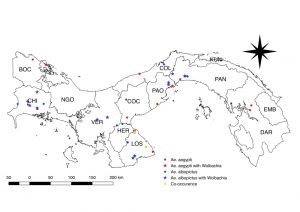Arthropod Microbiota
Principal investigators: Kelly L. Bennett & Jose R. Loaiza
Collaborators:Alejandro Almanza, Carmelo Gómez-Martínez, Yamileth Chin, Luis Fernando de Leon, Luis Mejia, Jose Rovira, W. Owen McMillan & Kristin Saltonstall
Background
Bacterial and fungal communities are important components of hematophagous arthropods (e.g., blood feeders) vectoring disease-causing pathogens to humans and wildlife, and they are likely to play a key role in vector ecology, evolution and transmission capacity. Several important human and animal diseases result from bacterial or fungal infection transmitted through the bite of arthropod vectors. Bacteria and fungi also interact with the arthropod host to reduce or increase the transmission of pathogens or indirectly alter disease dynamics through the modification of nutrition, development, reproduction or the immune response of arthropod vectors. Our understanding of the factors shaping the organization of bacterial and fungal communities in hematophagous arthropods vectoring human diseases is still limited.
Studies from members of the Culicidae Family (Mosquitoes) demonstrate the importance of the microbiome in modulating disease transmission. For example, Chromobacterium, Proteus and Paenibacillus bacteria can inhibit DENV replication in mosquitoes while the resident bacteria are required for its establishment. The intracellular bacterium Wolbachia is known to adversely influence the transmission of DENV, CHIKV, ZIKV, YFV and WNV. Alternatively, some bacteria are associated with an increase in disease transmission by their arthropod vectors. For example, members of Enterobacteriae are correlated with higher Plasmodium infection rates in Anopheles mosquitoes, while Serratia odorifera can increase the replication of both DENV and CHIKV in the midgut of Aedes aegypti.
Findings & developments
- We established a metagenomic approach to describe the organization of bacterial and fungal communities in major disease vector assemblages within the Order Diptera and the Family Ixodidae, including the geographical distribution of Wolbachia, a bacterium strain that can be used for vector population control across Panama.
- We discovered that phylogenetic relatedness and habitat quality are important predictors of the species composition and proportion of bacterial classes in arthropod disease vectors, with intraspecific differences in their bacterial associates shifting as a function of forest disturbance.
- We noticed that Ae. aegyptiand Ae. albopictusmosquitoes share a limited, yet highly variable core microbiota, reflecting high stochasticity within their oviposition habitats. Also, despite sharing a large proportion of microbiota, Ae. aegyptiharbours higher bacterial diversity than Ae. albopictus, primarily due to rarer bacterial groups at the larval stage.
- We reported a low incidence of natural Wolbachiainfection for both Aedes and its geographical distribution. This baseline information provides a foundation for studies on the functions and interactions of Aedes-associated bacteria with consequences for bio-control within Panama.
Relevant publications
- Kelly L. Bennett, Carmelo Gómez-Martínez, Yamileth Chin, Kristin Saltonstall, W. Owen McMillan, Jose R. Rovira, Loaiza JR.† 2019. Dynamics and diversity of bacteria associated with the disease vectors Aedes aegypti and Aedes albopictus. Scientific Reports,in press.
- Kelly L. Bennett, Alejandro Almanza, W. Owen McMillan, Kristin Saltonstall, Evangelina López Vdovenko, Jorge S. Vinda, Luis Mejia, Kaitlin Driesse, Luis F. De León, Loaiza JR.† 2019. Habitat disturbance and the organization of bacterial communities in Neotropical hematophagous arthropods. Plos One. in press.



